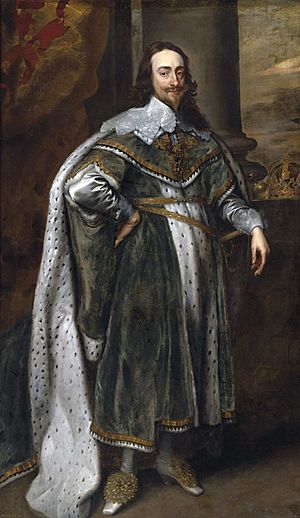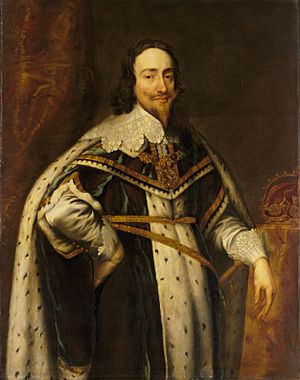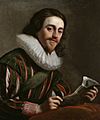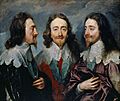Charles I of England facts for kids
Quick facts for kids Charles I |
|
|---|---|

Portrait from the studio of Anthony van Dyck, 1636
|
|
| King of England and Ireland (more...) | |
| Reign | 27 March 1625 – 30 January 1649 |
| Coronation | 2 February 1626 |
| Predecessor | James I |
| Successor |
|
| King of Scotland (more...) | |
| Reign | 27 March 1625 – 30 January 1649 |
| Coronation | 18 June 1633 |
| Predecessor | James VI |
| Successor | Charles II |
| Born | 19 November 1600 Dunfermline Palace, Dunfermline, Scotland |
| Died | 30 January 1649 (aged 48) Whitehall, London, England |
| Cause of death | Execution |
| Burial | 9 February 1649 St George's Chapel, Windsor Castle, England |
| Spouse | |
| Issue more... |
|
| House | Stuart |
| Father | James VI and I |
| Mother | Anne of Denmark |
| Religion | Anglican |
Charles I (born 19 November 1600 – died 30 January 1649) was the King of England, Scotland, and Ireland. He ruled from 1625 until he was put to death in 1649. He was born into the House of Stuart. Charles was the second son of King James VI of Scotland. When his father became King of England in 1603, Charles moved to England.
He became the next in line to the throne in 1612. This happened after his older brother, Henry Frederick, Prince of Wales, passed away. Charles tried to marry a Spanish princess, Maria Anna of Spain, but it didn't work out. Two years later, he married Henrietta Maria of France.
After becoming king in 1625, Charles often disagreed with the Parliament of England. Parliament wanted to limit his power. Charles believed in the "divine right of kings". This meant he thought God had chosen him to rule, and he should govern as he saw fit. Many people didn't like his policies. They especially disliked him raising taxes without Parliament's approval. They saw him as a tyrannical ruler, meaning he acted like a dictator.
His religious ideas also caused problems. He was married to a Roman Catholic queen. This made many Protestant groups, like the Puritans in England and Covenanters in Scotland, distrust him. They felt his views were too close to Catholicism. He supported high church Anglican leaders. He also didn't help Protestant forces much during the Thirty Years' War. His attempts to make the Church of Scotland use Anglican practices led to wars. These wars made the English and Scottish parliaments stronger. They also helped lead to his downfall.
From 1642, Charles fought against the armies of the English and Scottish parliaments. This conflict is known as the English Civil War. He lost the war in 1645. He then gave himself up to a Scottish army, who later handed him over to the English Parliament. Charles refused to agree to Parliament's demands for a constitutional monarchy. This would have meant sharing power with Parliament. He escaped for a short time in 1647. But he was caught again on the Isle of Wight. He then made a deal with Scotland. However, by late 1648, Parliament's army, called the New Model Army, had full control of England. Charles was put on trial. He was found guilty of acting against the country. He was put to death in January 1649. The monarchy was ended, and England became a republic called the Commonwealth of England. The monarchy was brought back in 1660, with Charles's son, Charles II, becoming king.
Contents
Early Life of King Charles I
Charles was born in Fife, Scotland. This was before his father became King of England. Charles had an older brother named Henry. Henry was smart, good-looking, and well-liked. He was next in line to become king. Sadly, Henry died suddenly in 1612. After Henry's death, Charles became Prince of Wales. This meant he was now the heir to the throne.
Charles was not as strong or clever as Henry. After his brother died, his closest friend was George Villiers, Duke of Buckingham. Buckingham was also his father's best friend. The Duke of Buckingham was very powerful and rich. But many ordinary people didn't like him. He took Charles to Spain. They hoped to find a Spanish princess for Charles to marry. But they had many problems on their trip. They couldn't convince the Spanish king to let his daughter marry Charles.
On their way home, they visited France. There, Charles met the French royal family. He later chose the youngest French princess, Henrietta Maria of France, to be his wife.
Charles I: King and Conflict with Parliament
When Charles became king, he needed money for a war with Spain. But Parliament would not give him the money he asked for. Because of this, he closed Parliament down. He did not call them together again for eleven years, from 1629 to 1640. This made many people unhappy. They didn't like paying taxes directly to the king. Parliament usually had to approve new taxes.
Many people also disliked the King's main advisor, William Laud. Laud was the Archbishop of Canterbury. He tried to make everyone in England use the same Anglican Prayer Book. He wanted to stop other Protestant groups that were growing popular.
When the King and Archbishop tried to force this Prayer Book on Scotland, the Scots rebelled. Scotland was even more Protestant than England. Now that the king was at war, he needed more money than ever. So, he had to call Parliament again in 1640. The members of Parliament were angry about what had happened for 11 years. They didn't want to give him money for his war. Instead, they spent their time complaining about the past 11 years. After only three weeks, Charles closed Parliament again. This Parliament was called the Short Parliament.
Without enough money, Charles lost the war badly. He even had to pay the Scots money he didn't have. This meant he had to call Parliament again, even though he didn't want to. One of the first things Parliament did was vote that the King had to call them regularly. He could not shut them down again. Charles had no choice but to agree. This Parliament became known as the Long Parliament. It lasted for twenty years, until 1660.
Parliament and the King then started arguing about who controlled the army. Each side ended up with its own army. This led to the English Civil War, which began in 1642. Parliament's army started winning the war. After a big defeat in 1646, Charles went to the Scots for protection. But they decided to hand him over to Parliament in 1647. Charles escaped at one point. He went to the governor of the Isle of Wight for safety. But this was also a bad choice. The governor was on Parliament's side and captured the king again. While he was held in the castle, Charles made a deal with the Scots. They joined his side, and fighting started again in 1648. Because he was still causing trouble even while captured, Parliament voted to put the king on trial. This had never happened to an English king before.
Death of Charles I
At his trial, Charles was found guilty. He was put to death by beheading in January 1649. Some members of Parliament who didn't want to kill King Charles were removed. From then on, the remaining part of the Long Parliament was called the Rump Parliament. This Parliament took complete power in England. There was no new king until 1660.
Images for kids
-
Engraving by Simon de Passe of Charles and his parents, King James and Queen Anne, c. 1612
-
Portrait by Robert Peake, c. 1611
-
Portrait of Charles as Prince of Wales after Daniel Mytens, c. 1623
-
Portrait by Gerrit van Honthorst, 1628
-
Rubens depicted Charles as a victorious and chivalrous Saint George in an English landscape, 1629–30.
-
Sixpence of Charles I, inscribed: CAROLUS D(EI) G(RATIA) MAG(NAE) BRIT(ANNIAE) FR(ANCIAE) ET HIB(ERNIAE) REX ("Charles, by the grace of God, King of Great Britain, of France and of Ireland")
-
Charles I with M. de St Antoine by Anthony van Dyck, 1633
-
Queen Henrietta Maria by van Dyck, 1632
-
A nineteenth-century painting depicting Charles (centre in blue sash) before the battle of Edgehill, 1642
-
Charles depicted by Wenceslaus Hollar on horseback in front of his troops, 1644
-
Charles, as painted by Sir Anthony van Dyck between 1637 and 1638
See also
 In Spanish: Carlos I de Inglaterra para niños
In Spanish: Carlos I de Inglaterra para niños




















